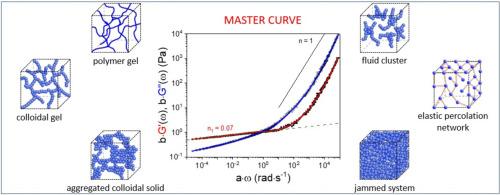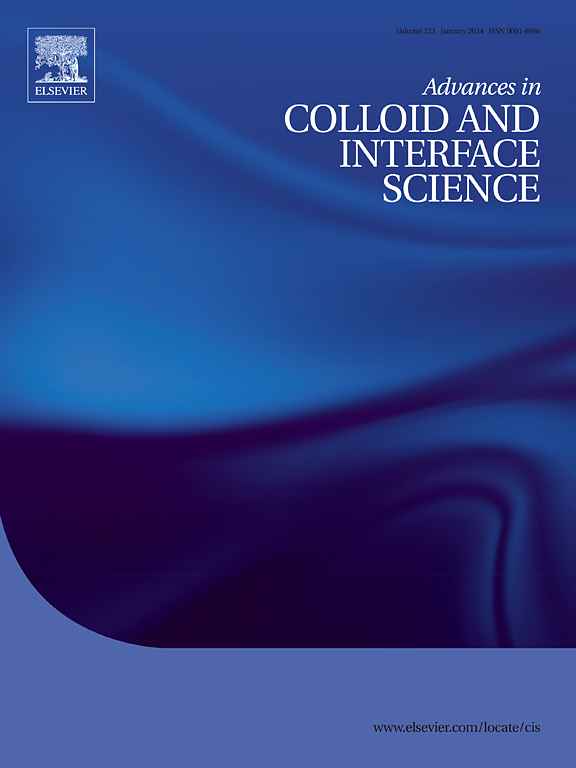低浓度下具有吸引力固体颗粒的胶体系统的粘弹特性:综述、新成果和解释。
IF 15.9
1区 化学
Q1 CHEMISTRY, PHYSICAL
引用次数: 0
摘要
本文涉及具有短程吸引力的胶体系统在体积分数 f 很小时的粘弹特性及其结构。与从模态耦合理论(MCT)角度可以很好理解的高ϕ体系不同,低ϕ体系仍然是基于不同概念(如渗流、扩散受限胶体聚集(DLCA)、干扰或群集模态耦合方法)的争论主题。在分析三个低 ϕ 值吸引力系统的实例之前,本研究讨论了与理解此类吸引力粒子的形成和特性相关的概念摘要。随后,我们重新分析了 i) 炭黑(CB)颗粒悬浮液、ii) 聚甲基丙烯酸甲酯(PMMA)硬质球悬浮液和 iii) 形成杆状物体的氨基酸有机凝胶分子悬浮液在低 ϕ 值下的行为。我们对这些体系的流变特性进行了详细研究,并将它们的反应解释为与干扰状态图相关的固体网络或由团块干扰形成的悬浮液所致。我们的分析表明,这三个系统实际上是团簇流体,其类似固体的响应与粘弹性响应的变化相对应,在低频下弹性分量 G' 变大,而粘滞分量 G" 变小。由于在 1 到 15 kBT 的几十倍范围内存在微弱的粒子间相互作用,因此在高频率下可逆地达到类似液体的状态,这体现在给定浓度下 G' 和 G "随频率变化而交叉。此外,所有这些具有吸引力的粒子系统在低ϕ条件下的两种模量都显示出一条主曲线,该曲线描述了这些团簇流体的特征,并允许对这些具有吸引力的粒子系统进行分类。本文章由计算机程序翻译,如有差异,请以英文原文为准。

Viscoelastic properties of colloidal systems with attractive solid particles at low concentration: A review, new results and interpretations
This paper concerns the viscoelastic properties and the resulting structure of colloidal systems with short-range attractions in the regime where the volume fraction f is small. Unlike the high ϕ regime, which is well understood in terms of mode-coupling theory (MCT), the low ϕ regime is still the subject of a debate based on different concepts such as percolation, diffusion-limited colloidal aggregation (DLCA), jamming, or cluster mode-coupling approach. Prior to the analysis of three examples of attractive systems at low ϕ values, a summary of concepts relevant to understanding the formation and properties of such attractive particles is discussed in the present study. Afterwards, we re-analyze the behaviour at a low ϕ of i) suspensions of carbon black (CB) particles, ii) suspensions of poly(methyl methacrylate) (PMMA) hard spheres with a depletion attraction induced by the addition of polystyrene (PS), and iii) suspensions of amino acid organogelator molecules which form rod-like objects. The rheological properties of these systems have been studied in detail and their response has been interpreted as being due either to a solid network discussed in relation to the jamming state diagram or to a suspension formed by jamming of clusters. Our analysis shows that these three systems are in fact cluster fluids and that their solid-like response corresponds to a change in their viscoelastic response, the elastic component G' becoming greater than the viscous component G" at low frequencies. Due to the presence of weak interparticle interactions in the tens range from 1 to 15 kBT, a liquid-like state is reversibly achieved at high frequencies, as indicated by the crossover of G' and G" as a function of frequency for a given concentration. Moreover, all these attractive particle systems at low ϕ show for both moduli a master curve which characterizes these cluster fluids and allows for the classification of these attractive particle systems.
求助全文
通过发布文献求助,成功后即可免费获取论文全文。
去求助
来源期刊
CiteScore
28.50
自引率
2.60%
发文量
175
审稿时长
31 days
期刊介绍:
"Advances in Colloid and Interface Science" is an international journal that focuses on experimental and theoretical developments in interfacial and colloidal phenomena. The journal covers a wide range of disciplines including biology, chemistry, physics, and technology.
The journal accepts review articles on any topic within the scope of colloid and interface science. These articles should provide an in-depth analysis of the subject matter, offering a critical review of the current state of the field. The author's informed opinion on the topic should also be included. The manuscript should compare and contrast ideas found in the reviewed literature and address the limitations of these ideas.
Typically, the articles published in this journal are written by recognized experts in the field.

 求助内容:
求助内容: 应助结果提醒方式:
应助结果提醒方式:


